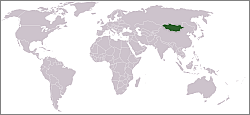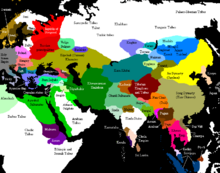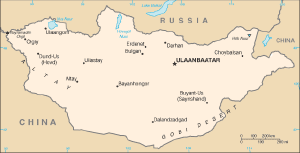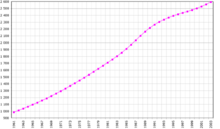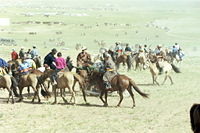Mongolia
| Монгол Улс Bügd Nairamdah Mongol Uls Mongolia |
||||||
|---|---|---|---|---|---|---|
|
||||||
| Motto: "Даяр Монгол (Dayar Mongol)" | ||||||
| Anthem: Bügd Nairamdakh Mongol |
||||||
| Capital (and largest city) | Ulaanbaatar 47°55′N 106°53′E | |||||
| Official languages | Mongolian | |||||
| Government | Parliamentary democracy | |||||
| - | President | Nambaryn Enkhbayar | ||||
| - | Prime minister | Miyeegombo Enkhbold | ||||
| Formation | ||||||
| - | National Foundation Day | 1206 | ||||
| - | Independence | July 11, 1921 | ||||
| Area | ||||||
| - | Total | 1,564,116 km² (19th) 603,909 sq mi |
||||
| - | Water (%) | 0.6 | ||||
| Population | ||||||
| - | July 2005 estimate | 2,646,000 (139th) | ||||
| - | 2000 census | 2,650,952 | ||||
| GDP (PPP) | 2005 estimate | |||||
| - | Total | $5.56 billion (147th) | ||||
| - | Per capita | $2,175 (137th) | ||||
| Currency | Tugrug (MNT) |
|||||
| Time zone | (UTC+7) | |||||
| - | Summer (DST) | (UTC+8) | ||||
| Internet TLD | .mn | |||||
| Calling code | +976 | |||||
Mongolia (Mongolian: Монгол Улс) is a landlocked country located in East Asia. Mongolia is also sometimes classified as being a part of Central Asia, depending on the definition used. It is bordered by Russia to the north and the People's Republic of China to the south. Its capital and largest city is Ulaanbaatar.
Mongolia was the center of the Mongol Empire in the 13th century and was later ruled by China during the Manchu Qing Dynasty from the end of the 18th century until 1921, when an independent government was formed with Soviet assistance. Following the end of the Cold War, and after the fall of communism in Mongolia in 1990, Mongolia adopted democracy via elections. A new, democratic constitution which was ratified in 1992 officially marked the birth of Mongolia as a democratic country, making it one of the world's youngest democracies.
At 1,564,116 square km, Mongolia is the 18th largest country in the world. However, the country contains very little arable land as much of its area is covered by arid and unproductive steppes with mountains to the north and west and the Gobi Desert to the south. Approximately 30 percent of the country's 2.8 million people are nomadic or semi-nomadic. The predominant religion in Mongolia is Tibetan Buddhism, and the majority of the state's citizens are of the Mongol ethnicity, though many Kazakhs and Tuvans also live in the country, especially in the west. About one-third of the population lives in Ulaanbaatar.
History
A large number of ethnicities have inhabited Mongolia since prehistoric times. Most of these people were nomads who from time to time formed great confederations that rose to prominence. The first of these, the Xiongnu, were brought together to form a confederation by Modu Shanyu in 209 B.C.E. They defeated the Donghu, who had previously possessed the hegemony in eastern Mongolia. The Xiongnu became the greatest enemy of China for the following three centuries. The Great Wall of China was built partly as defence against the Xiongnu. Marshal Meng Tian of the Qin Empire dispersed more than 300,000 soldiers along the Great Wall to prevent an expected invasion from the North. It is believed that after their decisive defeat by the Chinese in 428-431, some of the Xiongnu migrated West to become the Huns. After the Xiongnu migrated west, Rouran, a close relative of the Mongols, came to power before being defeated by the Gokturks, who then dominated Mongolia for centuries.
Early history
During the 7th and 8th centuries, Mongolia was controlled by Gokturks, who were succeeded by the ancestors of today's Uigur and then by the Khitan and Jurchen. By the 10th century, the country was populated predominantly by Mongols believed to be a branch of the Xianbei. During this period the country was divided into numerous tribes linked through transient alliances.
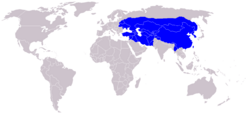
In the late 12th Century, a chieftain named Temujin united the Mongol tribes to the Naiman and Jurchen after a long struggle and took the name of Genghis Khan. Starting in 1206, Genghis Khan and his successors consolidated and expanded the Mongol Empire into the largest contiguous land empire in world history. After Genghis Khan's death, the empire was divided into four kingdoms, or "Khanates." One of these, the "Great Khanate," comprised the Mongol homeland and China, and its emperors were known as the Yuan Dynasty. Its founder, Kublai Khan, set up his centre of administration in present day Beijing. After more than a century of power, the Yuan Dynasty was replaced by the Ming Dynasty in 1368, and the Mongol court fled north. The Ming armies pursued and defeated them in Mongolia, but did not conquer Mongolia.
During the next few centuries, Mongolia was split between the Oirad in the west and the Khalkha in the east. Altan Khan united the Mongols briefly in 1571. After failing to defeat the Chinese, he made peace with the Ming Dynasty and instead attacked Tibet, eventually becoming a convert to Tibetan Buddhism.
During the 17th Century, the Manchus rose to prominence in the east, and they conquered Inner Mongolia in 1636 and Outer Mongolia in 1691. For the next 200 years Mongolia was ruled by the Manchus, whose rulers became the Qing Dynasty. During this time, the Manchus maintained their control over Mongolia with a series of alliances and intermarriages, as well as military and economic control. Several Emperors of the Qing Dynasty were born to Mongol mothers.
With the fall of the Qing Dynasty, Mongolia declared independence in 1911. The new country's territory was approximately that of the former Outer Mongolia. After the October Revolution in Russia, Chinese troops led by Xu Shuzheng attacked and occupied the capital in 1919. The Chinese rule did not last: notorious Russian adventurer "bloody" Baron Ungern who had fought with the "Whites" (Ataman Semyonov) against the Red army in Siberia, led his troops into Mongolia and forced a showdown with the Chinese in Ulaanbaatar. Ungern's cossacks triumphed, and he briefly in effect ruled Mongolia under the blessing of religious leader Bogd Khaan. But Ungern's triumph was shortlived; he was chased out by the Red Army, which, while at it, "liberated" Mongolia from feudalism and insured its political alignment with the Russian Bolsheviks. In 1924, after the death of the religious leader Bogd Khan, the Mongolian People's Republic was proclaimed and was backed by the Soviets.
Alignment with Soviet Union
The Mongolian People's Republic was aligned closely with the Soviet Union. Politicians who demanded a more capitalist course and who dissented against collective prosperity, like Dogsomyn Bodoo or Horloogiyn Dandzan, quickly became unpopular. In 1928, Horloogiyn Choybalsan rose to power. Under his administration, forced but productive collectivisation was instituted, and the destruction of Buddhist monasteries in 1937 left more than 10,000 insurgent lamas dead.
During the Soviet-Japanese Border War of 1939, the USSR defended Mongolia against Japan during the Battle of Halhin Gol. Mongolian forces also took part in the Soviet offensive against Japanese forces in Inner Mongolia in August 1945 (see Operation August Storm). The threat of Mongolian forces seizing parts of Inner Mongolia induced the Republic of China to recognize Outer Mongolia's independence, provided that a referendum was held. The referendum took place on October 20 1945, with (according to official numbers) 100% of the electorate voting for independence. After the establishment of the People's Republic of China, both countries recognized each other on October 6, 1949.
After Choybalsan died in Moscow on January 26, 1952, Yumjaagiyn Tsedenbal took power. In 1956 and again in 1962, Choybalsan's personality cult was condemned. Mongolia continued to align itself closely with the Soviet Union, especially after the Sino-Soviet split of the late 1950s. While Tsedenbal was visiting Moscow in August 1984, his severe illness prompted the parliament to announce his retirement and replace him with Jambyn Batmonh.
1990 Democratic Revolution
The introduction of perestroika and glasnost in the USSR by Mikhail Gorbachev strongly influenced Mongolian politics even though Mongolia was a sovereign nation. The collapse of communism in the Soviet Union, combined with these two policies, were enough to lead to a peaceful democratic revolution in Mongolia in 1990. This, in turn, allowed Mongolia to begin engaging in economic and diplomatic relations with the Western world. The nation finished its transition from a communist state to a multi-party free-market democracy with the ratification of a new constitution in 1992.
Government and politics
Until June 27, 2004, the predominant party in Mongolia was the ex-communist Mongolian People's Revolutionary Party, or MPRP, which was formed by Mongolia's communist leaders after the end of the Cold War. The main opposition party was the Democratic Party or DP, which controlled a governing coalition from 1996 to 2000.
From 2000 to 2004 MPRP was back in power, but results of the 2004 elections required the establishing of the first ever coalition government in Mongolia between the MPRP and MDC (Motherland Democratic Coalition).
The President
Mongolia's president has a symbolic role. Mongolia's Constitution provides three requirements for taking office as President: the individual must be a native-born Mongolian, who is at least 45 years of age, and who has resided in Mongolia for five years prior to taking office. The current President is Nambaryn Enkhbayar.
The Parliament (State Great Hural)
Mongolia uses a unicameral parliamentary system in which the president has a symbolic role and the "government" chosen by the legislature exercises executive power. The legislative arm, the State Great Hural, has one chamber with 76 seats and is chaired by the speaker of the house.
On January 14, 2006, the parliament's 39 members, mostly MPRP but including 4 Democratic Party members (Mendsaikhan Enkhsaikhan, Narantsatsralt, Mishig Sonompil, and J. Batkhuyag), overthrew Democrat Tsakhiagiyn Elbegdorj's grand coalition government. It has been claimed that this violated the Constitution, as the parliament exceeded its power. The decision to overthrow Elbegdorj's government was based on the MPRP Directing Board's decision, contrary to its three agreements with the Democratic Party. The action has been protested.
The Prime Minister and Cabinet
The prime minister is elected by the State Great Hural. The current prime minister is Miyeegombo Enkhbold, who was elected by 56 votes to 10 on January 25, 2006. The deputy prime minister is Mendsaikhan Enkhsaikhan (since 28 January 2006).
The cabinet is nominated by the prime minister in consultation with the president, and confirmed by the State Great Hural.
Judiciary
The judges of the Supreme Court are nominated by a General Council of Courts and confirmed by the State Great Hural and the President. However there is also a Constitutional Court, as the Supreme Court does not have jurisdiction to interpret the Constitution.
Foreign relations and military
Mongolia maintains friendly relations with the United States, Russia, Japan, the People's Republic of China, and virtually all countries in the world. It has initiated large foreign investment initiatives and encouraged foreign investment. It supported the 2003 invasion of Iraq, or "Operation Iraqi Freedom," and has sent 200 troops to Iraq. On November 21, 2005, George W. Bush became the first ever sitting U.S. President to visit Mongolia.
Geography and climate
At 604,209 mi² (1,565,000 km²[1]), Mongolia is the world's 19th-largest country (after Iran). It is significantly larger than the next-largest country, Peru, and is nearly as large as the US state of Alaska.
The Mongolian heartland consists of relatively flat steppes. The southern portion of the country is taken up by the Gobi Desert, while the northern and western portions are mountainous. The highest point in Mongolia is Nayramadlin Orgil (Huyten Orgil) at 4,374 m (14,350 feet). Uvs Nuur Lake, shared with Tuva Republic in the Russian Federation, is a natural World Heritage Site.
Most of the country is hot in the summer and extremely cold in the winter, with January averages dropping as low as -30ºC (-22ºF). The country is also subject to occasional harsh climatic conditions known as zud or dzud. Ulaanbaatar has the coldest average temperature of any national capital in the world.
Mongolia is high, cold, and dry. It has an extreme continental climate with long, cold winters and short summers, during which most of its annual precipitation falls. The country averages 257 cloudless days a year, and it is usually at the center of a region of high atmospheric pressure. Precipitation is highest in the north (average of 20 to 35 centimeters per year) and lowest in the south, which receives 10 to 20 centimeters annually. The extreme south is the Gobi, some regions of which receive no precipitation at all in most years. The name "Gobi" is a Mongol term for a desert, depression, salt marsh, or steppe, but which usually refers to a category of arid rangeland with insufficient vegetation to support marmots but with enough to support camels. Mongols distinguish Gobi from desert proper, although the distinction is not always apparent to outsiders unfamiliar with the Mongolian landscape. Gobi rangelands are fragile and are easily destroyed by overgrazing, which results in expansion of the true desert, a stony waste where not even Bactrian camels can survive.
Administrative divisions
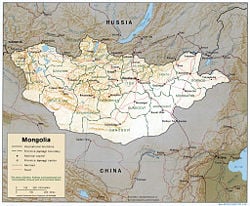
Mongolia is divided into 21 Aymguud (provinces) (sing. aimag or aymag) and 1 municipality (khot) with provincial status.
- Arhangay
- Bayan-Ölgiy
- Bayanhongor
- Bulgan
- Darhan-Uul
- Dornod
- Dornogovĭ
- Dundgovĭ
- Govĭ-Altay
- Govĭsümber
- Hentiy
- Hovd
- Hövsgöl
- Ömnögovĭ
- Orhon
- Övörhangay
- Selenge
- Sühbaatar
- Töv
- Ulaanbaatar (municipality)
- Uvs
- Zavhan
The Aymguud are further sub-divided into 315 Somon ("districts") (sing. Sum).
See also:
- Somon of Mongolia
Economy
Mongolia's economy is centered on agriculture and mining. Mongolia has rich mineral resources, and copper, coal, molybdenum, tin, tungsten, and gold account for a large part of industrial production. In the 1990s, the disappearance of Soviet aid due to the fall of the Soviet Union accounted for the closing of many industrial facilities in Mongolia. Following decades of state-run enterprise, the economy began a transition to capitalism, occasionally painfully; in 2000-2002, opposition to privatization, as well as droughts and other natural disasters, contributed to a negative GDP growth. However, growth picked up in 2004 and 2005 with increases of 10.6% and 5.5%, respectively, largely due to the high price of commodities (gold and copper).
There are currently over 30,000 independent businesses in Mongolia, chiefly centered around the capital city [citation needed]. The majority of the population outside urban areas participate in subsistence herding; livestock typically consists of cows, sheep, goats, horses, and Bactrian camels. Agricultural crops include wheat, barley, vegetables, and other forage crops.
GDP per capita in 2005 was $1,900 [2]. Although GDP has risen steadily since 2002 at the rate of 6.2% in an official 2005 estimate, the state is still working to overcome a sizable trade deficit. A massive ($11 billion) foreign debt to Russia was settled by the Mongolian government in 2004 with a $250 million payment; this reduced value was accepted due to Mongolian hardship and the loss of human lives during the Soviet Era.[1] Mongolia joined the World Trade Organization in 1997, seeking to integrate itself in the Asian regional economies, and now it exports cashmere, minerals, and food products to Russia, the United States, China, Japan, Italy, and other countries.
Despite growth, the proportion of the population below the poverty line is estimated to be 36.1% in 2004, and both the unemployment rate and inflation rate are high at 6.7% and 10.9%, respectively [3].
Industrial sector
Industry currently accounts for 21.4% of GDP, approximately equal to the weight of the agriculture sector (20.4%). These industries include construction and construction materials, mining (coal, copper, molybdenum, fluorspar, tin, tungsten, and gold), oil, food and beverages, processing of animal products, and cashmere and natural fiber manufacturing. The industrial production growth rate is estimated to be 4.1% in 2002. [4]
Science and technology
Mongolia has increasingly started to develop its technology industry since the democratic revolution of the early 1990s, and many new technology companies have been founded. Also, some technology companies in nearby countries, such as Korea and China, have started to open offices in Mongolia.
Service sector
After the democratic revolution of the early 1990s, Mongolian domestic production has picked up providing basic food production to its residents through increasing competition among companies. According to the CIA World Factbook, in 2003, the service sector accounted for 58% of the GDP, with 29% of the labor force of 1.488 million involved.
Infrastructure
Mongolia has a relatively small and undeveloped infrastructure in terms of roads and electricity. Due to the nomadic nature of some parts of the population, the vast majority of the roadways are unpaved. However, investment from Korea and other countries have helped add more paved roads and electricity access to remote locations in Mongolia. The Trans-Siberian railway passes through Mongolia between China and Russia. There are 48 airports throughout the country, including one international airport in Ulaanbaatar, with service to China, Korea, Japan, Germany, Russia, and other countries. The air transport company of Mongolia is MIAT.
The petroleum products and electricity used to power the infrastructure are in large part (80%) imported from Russia, which makes Mongolia vulnerable to supply side shocks. This is one strong example of the influence of Mongolia's neighbors on its economy.
Demographics
Though the majority of Mongolian citizens are of Mongol descent there are small populations of Kazakh, Tuvan and Tungus peoples. Mongolia's population growth rate is estimated at 1.54% (2000 census). About two-thirds of the total population is under age 30, 36% of whom are under 14. This relatively young and rapidly growing population has, as in many developing countries, placed strains on Mongolia's economy. According to the World Factbook, 50% of Mongolia's population are Buddhist-Lamaist, which is related to Tibetan Buddhism. 40% are atheist, 6% are Shamanist or Christian, and 4% are Muslim.
Life in sparsely populated Mongolia has become more urbanized. Nearly half of the people live in the capital and in other provincial centers. Seminomadic life still predominates in the countryside where many families stay in villages during the cold winters and live in gers during the summer, though agricultural communities that are settled year-round are becoming more common.
Ethnic Mongols account for about 85% of the population and consist of Khalkha and other groups, all distinguished primarily by dialects of the Mongol language. Mongol is an Altaic language—from the Altaic Mountains of Central Asia, a language family comprising the Turkic, Tungusic, and Mongolic subfamilies—and is related to Turkic (Uzbek, Turkish, Tatar and Kazakh), and possibly Korean and Japanese. The Khalkha make up 90% of the ethnic Mongol population. The remaining 10% include Durbet Mongols and others in the north and Dariganga Mongols in the east. Turkic speakers (Kazakhs, Tuvans, and Uyghurs) constitute 7% of Mongolia's population, and the rest are Tungusic-speakers, Chinese, and Russians. Most, but not all, Russians left the country following the withdrawal of economic aid and collapse of the Soviet Union in 1991.
Language
The official language of Mongolia is Khalkha Mongol, which uses the Cyrillic alphabet, but there are variety of different dialects across the country. In the more western parts of the country, where there is more ethnic diversity, primarily due to populations of ethnic Tuvans and Kazakhs, the Tuvan language and Kazakh language, among others, are also spoken. In the northern parts of the country, Russian language is frequently spoken among the Russian populations. Furthermore, the Mongolian government has worked to encourage the learning of English as a second language by having it replace the teaching of Russian in schools.
Religion
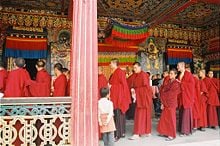
Aside from brief periods of Islam and Christianity, various forms of shamanism have been widely practiced throughout the history of what is now modern day Mongolia, as such beliefs were common among nomadic people in Asian history. Such beliefs gradually gave way to Tibetan Buddhism, but shamanism has left a mark on Mongolian religious culture. Indeed, some shamanistic practices and traditions are still practiced in rural areas.
Throughout much of the 20th century, the communist government ensured that the religious practices of the Mongolian people were largely repressed. Horloogiyn Choybalsan complied with the orders of Joseph Stalin, destroying almost all of Mongolia's over 700 Buddhist monasteries and killing thousands of monks. The fall of communism in 1991 restored the legality of public religious practice, and Tibetan Buddhism, which had been the predominant religion in the region before the rise of Communism, again rose to become the most widely practiced religion in Mongolia. The end of religious repression in the 1990s also allowed for other religions, such as Christianity, to spread in the country.
Education
During much of 1970s and 1980s, the communist government emphasized large education initiatives, and as a result the public school system was very powerful and prevalent. Chemistry, Russian language and mathematics were emphasized. After the 1990 democratic revolution, study of different foreign languages began to pick up speed. Mongolia has a very high literacy rate with around 96% able to read and write. After the democratic revolution, many private colleges and schools were created, offering wide variety of studies, especially in the English language. Mongolia has named English the second official language of Mongolia, replacing Russian.
Mongolia also has large state universities such as National University of Mongolia and Mongolian University of Science and Technology, plus many other institutions and colleges are educating Mongolia's next generation throughout the city of Ulaanbaatar.
Health
Health care in Mongolia is rapidly improving, leading to a higher life expectancy.
Culture
The culture of Mongolia can be described as homogeneous. 96% of the Mongolia's population is Vajrayana Buddhist in the Tibetan tradition. The official language, Khalkha Mongol, is spoken by 90% of the population. Mongolia has its own ethnic group, which comprises 85% of the country's population.
Mongolia's population is about 2.6 million. 65% are in the 16-64 age bracket, and about 4% are over 64. HIV/AIDS has not made a significant impact, with only about 16 reported cases in the whole country.
Childbirth is 2.26 per woman, and the increase rate is high. Average life expectancy is 63 years, and the infant mortality rate is at 6%.
The main festival is Naadam, which celebrates the anniversary of Mongolian independence from China. It is held on July 11 to July 13, and consists of three Mongolian traditional sports: archery, horse-racing (over long stretches of open country, not the short racing around a track practiced in the West), and wrestling. Very popular is the "flicking" of sheep footbones at a target several feet away, using a flipping motion of the finger to send the small bone flying at a target and trying to knock the target bone off the platform. This contest at Naadam is very popular and develops a serious audience.
In Mongolia, the khoomii, or throat singing, style of music is popular, particularly in Western Mongolia.
The ornate symbol in the leftmost bar of the national flag is a Buddhist icon called a soyonbo. It represents the sun, moon, stars, and heavens per standard cosmologic symbology abstracted from that seen in traditional Tibetan thangka paintings.
Sports and recreation
The most famous sports competition is held during the Naadam festival in the summer for three days and includes horse racing, archery, and Mongolian wrestling. These three sports are the most widely watched and practiced throughout the country. Skiing and other winter sports, many of which were introduced during the communist era, are also common.
Other sports such as table tennis, basketball, and soccer are increasingly getting popular. More Mongolian table tennis players are competing internationally.
See also
- Communications in Mongolia
- Foreign relations of Mongolia
- Military of Mongolia
- Mongoliyn Skautiyn Holboo
- Public holidays in Mongolia
- Transportation in Mongolia
- Greater Mongolia region
- Inner Mongolia
ReferencesISBN links support NWE through referral fees
This article incorporates text from the Library of Congress Countries Study, which is in the public domain.
- ↑ "Gift on a New Year Eve". Bizmongolia.com, January 01. 2004
External links
General
- News and Information Association of Mongolia - www.moninfo.org Online daily news in English and Mongolian
- Open Directory Project - Mongolia
- Encyclopaedia Britannica's Mongolia Country Page
- CIA World Factbook - Mongolia
- MongolianArtist.com - News and Culture Site
- Flags of the Mongolian aymags
- The UB Post Independent English Weekly News
Official
- Mongolia Open Government from the Office of the Prime Minister
- Mongolia Ministry of Foreign Affairs official site
- Mongolian Tourist Board
- US Department of State - Mongolia includes Background Notes, Country Study and major reports
Reports and pictures
- Photographical reportages by Michel Setboun
- Plants of Mongolia
- Birds of Mongolia
- Collection of pictures from Mongolia sorted by province
- 21 Days In Mongolia Gallery and diary of a backpackers trip to Mongolia
Template:Central Asia
Template:East Asia
Template:Asia
Credits
New World Encyclopedia writers and editors rewrote and completed the Wikipedia article in accordance with New World Encyclopedia standards. This article abides by terms of the Creative Commons CC-by-sa 3.0 License (CC-by-sa), which may be used and disseminated with proper attribution. Credit is due under the terms of this license that can reference both the New World Encyclopedia contributors and the selfless volunteer contributors of the Wikimedia Foundation. To cite this article click here for a list of acceptable citing formats.The history of earlier contributions by wikipedians is accessible to researchers here:
The history of this article since it was imported to New World Encyclopedia:
Note: Some restrictions may apply to use of individual images which are separately licensed.


